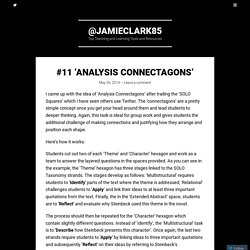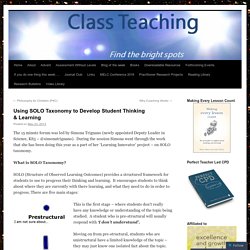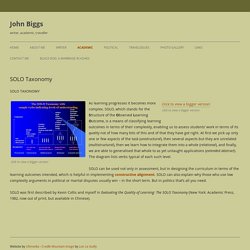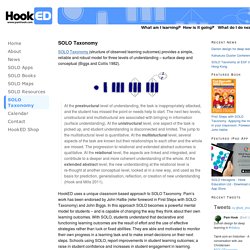Zoom
Trash
Related: Apprendre à apprendre
- T³ doc de référence
- Pedagogía
- SOLO taxonomy
- Education
- Enterprise

#11 ‘Analysis Connectagons’ I came up with the idea of ‘Analysis Connectagons’ after trailing the ‘SOLO Squares’ which I have seen others use Twitter.

The ‘connectagons’ are a pretty simple concept once you get your head around them and lead students to deeper thinking. Again, this task is ideal for group work and gives students the additional challenge of making connections and justifying how they arrange and position each shape. Here’s how it works: Students cut out two of each ‘Theme’ and ‘Character’ hexagon and work as a team to answer the layered questions in the spaces provided. As you can see in the example, the ‘Theme’ hexagon has three stages linked to the SOLO Taxonomy strands. The process should then be repeated for the ‘Character’ hexagon which contain slightly different questions. Once the shapes are filled in with top-notch ideas, the final challenge is to put them together (like a big jigsaw).
This task is a great way of making progress visible and stimulates effective group discussion. PE Revision Using Solo Taxonomy. SOLO Taxonomy - Defining the stages. SOLO Taxonomy: Student Questioning Framework for Inquiry. SOLO Taxonomy: Teaching English in a Secondary School. Solo taxonomy lesson example. Solo taxonomy lesson example. Using SOLO Taxonomy to Develop Student Thinking & Learning. The 15 minute forum was led by Simona Trignano (newly appointed Deputy Leader in Science, KS3 – @simonatrignano).

During the session Simona went through the work that she has been doing this year as a part of her ‘Learning Innovator’ project – on SOLO taxonomy. What is SOLO Taxonomy? SOLO (Structure of Observed Learning Outcomes) provides a structured framework for students to use to progress their thinking and learning. It encourages students to think about where they are currently with there learning, and what they need to do in order to progress. There are five main stages: This is the first stage – where students don’t really have any knowledge or understanding of the topic being studied.
Moving on from pre-structural, students who are unistructural have a limited knowledge of the topic – they may just know one isolated fact about the topic. LOOK OUT FOR LEARNING. The Structure of Observed Learning Outcome (SOLO) taxonomy is a model of learning that: “Provides a simple and robust way of describing how learning outcomes grow in complexity from surface to deep understanding” Biggs and Collin (1982)Is similar to Bloom’s taxonomy but it has one major advantage: SOLO taxonomy provides a user friendly, common language of learning that enables the student and teacher to explicitly understand the learning process.

The 5 levels of understanding are: Pre-structural – The task is not attacked appropriately; the student hasn’t really understood the point and uses too simple a way of going about it.Uni-structural – The student’s response only focuses on one relevant aspect.Multi-structural – The student’s response focuses on several relevant aspects but they are treated independently and additively. Assessment of this level is primarily quantitative.Relational – The different aspects have become integrated into a coherent whole. 1. 2. 3. 4. 5. 6. 7. Shakespeare, SOLO taxonomy and taking risks (Part 2) So, the risk paid off and I got the job.

I am now Director for English and Literacy at Clevedon School, which has a pleasingly grand ring to it. You’ll remember the brief of the interview lesson was to teach a 40 minute Shakespeare master class to a group of 30 mixed ability Year 8 students which introduced a pedagogical thinking tool. Easy. Learner Evolution ~ Chris Harte: SOLO Taxonomy. Using SOLO taxonomy at Key Stage 3. PLC_Workshop_2_Solo_Taxonomy_13-14.pptx. Teaching SOLO taxonomy through SOLO taxonomy. When I first started this blog, I was always quite keen to stay away from writing 'How to guides' or give detailed theoretical explanations of particular aspect of learning & teaching.

Mainly because there are so many amazing educators out there who have already explained it and probably in a much better way than I ever will. I also like to 'tinker' with ideas and normally what I deliver in my teaching is an adapted version, usually pitched to the students that I learn with. But, I feel I am about to buck the trend and go against my initial aims. I am about to join the dark side! I first read about SOLO in 2009 but at the particular point I wasn't ready in my theory teaching to implement it. So now, back in 2012, I seem to have caught the SOLO bug and went on a big secret trial with my Year 10 & 11 GCSE PE theory groups. So, whatever I do, whether leading sessions for staff or teaching in lessons, I always think 'What could I do that helps people really get what I am talking about'.
SOLO Taxonomy - Onehunga Primary School. The SOLO taxonomy is used throughout our school to help children extend their learning through the use of thinking maps.

SOLO maps enhance thinking skills that extend children beyond their current experiences. The children learn to understand and use this language and this sets them on a path for lifelong skills in learning. SOLO is divided into a number of levels of learning: Prestructural where a child needs support in expressing an idea on the topic. Unistructural where a child can express one relevant idea. Here is an example of a statement at the multi-structural level written by a Year 2 child – this statement was written after the child had completed a 'describe' map.
SOLO Taxonomy. The Structure of Observed Learning Outcomes Taxonomy (SOLO) is a notion that describes the stages of learning that students go through to reach a real depth of understanding on a topic.

It outlines the journey from surface to deep learning. SOLO is John Hattie’s taxonomy of choice and is currently being studied in depth at his Visible Learning Labs (Osiris Educational Outstanding Teaching Conference, 2014). It is seen by Hattie and other academics as having many advantages over other taxonomies, in particular that of Benjamin Bloom. SOLO Taxonomy in Maths on Pinterest. SOLO Taxonomy Resources. SOLO Taxonomy: giving students a sense of progress in learning.
Without a sense of progress you cannot be creative, so what language can we offer students that enables them to take control of understanding where they are in their learning?

One key notion about creativity is that the ability to calculate progress is an important part of the creative process: knowing when something feels 'done'. Knowing when you're stuck, when you're done, when you're at the end of that chunk of learning is essential. It gives that indication that you need to go back out and get some more insights from someone or something. SOLO taxonomy explained using Lego. SOLO Taxonomy. Click to view a bigger version As learning progresses it becomes more complex.

SOLO Taxonomy. SOLO Taxonomy (structure of observed learning outcomes) provides a simple, reliable and robust model for three levels of understanding – surface deep and conceptual (Biggs and Collis 1982).

At the prestructural level of understanding, the task is inappropriately attacked, and the student has missed the point or needs help to start. The next two levels, unistructural and multistructural are associated with bringing in information (surface understanding). At the unistructural level, one aspect of the task is picked up, and student understanding is disconnected and limited. The jump to the multistructural level is quantitative. At the multistuctural level, several aspects of the task are known but their relationships to each other and the whole are missed. SOLO taxonomy. I am pleased to say that John Biggs himself has endorsed this representation of his ideas; "I've just found your website on SOLO et al. via google. I'm delighted! Your diagrams of prestructural-extended abstract are very elegant...
" (Unsolicited email, 29 May 2005)